For years, I’d been searching for a bronze Buddha statue to place on my home altar. I knew the pose I preferred, the one known as Calling The Earth to Witness. It depicts Buddha sitting with legs crossed in full lotus position, left hand resting in his lap palm upward and right hand resting on his knee with fingers pointing to the ground, palm inward. It is the definition of the moment of enlightenment for the Buddha. None of the images I considered were quite right, until I walked into a small antique shop on the east side of the Ping River in Chiang Mai, Thailand. I knew the moment I laid eyes on it that this was the bronze Buddha I’d been seeking. It spoke to me in a way that none of the others had. I carried it home and lovingly placed it on my altar but there was still something missing. My Buddha image needed to be awakened in a Buddha statue consecration ceremony.
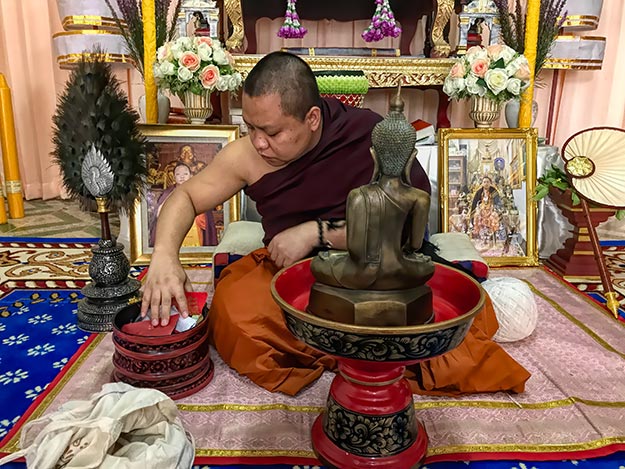
With the help of my Thai friends, I identified a monk who spoke a little English, Phrapalad Thanwa Khayantam, who agreed to perform the ceremony. I met him one afternoon at at Wat Cheatawan, located just outside the walls of the Old City. He sat cross-legged on the floor and began by inspecting my Buddha image. He turned it upside-down and grunted with approval when he saw it was hollow and sand cast. I asked if he could read old Lanna script and pointed out the inscription on the base of the image. I explained that two different people had translated the inscription as, “Immortal Chiang Saen Buddha.” Phrapalad Thanwa agreed with their translation, adding that the image was very old, perhaps dating to the 12th century. He also opined that it came from Myanmar.
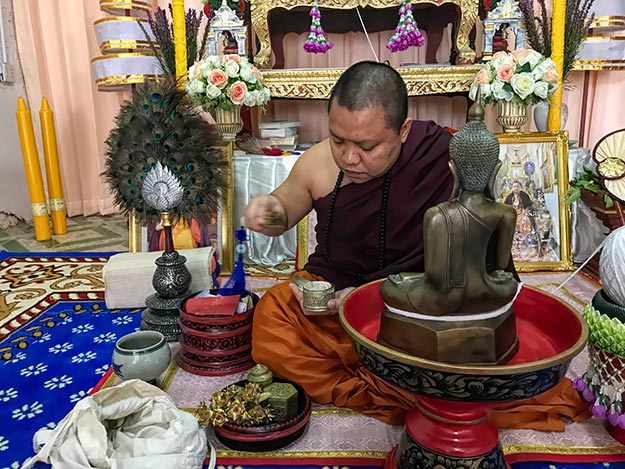
He began preparing the space for the “Consecration of the Buddha Ceremony.” First, he placed my Buddha on a round red and black lacquered pedestal table. From an altar he retrieved a tall fan of iridescent peacock feathers, mounted in an ornate base of inlaid black onyx and white abalone. Next he brought out a set of cylindrical, black and red lacquered stacking trays. The top tray held several intricately carved brass trinket boxes. A round one held a white clay powder known as din sawh phong, while a hexagonal-shaped one held small squares of cotton gauze. A small bottle of sacred oil was set among the brass boxes.
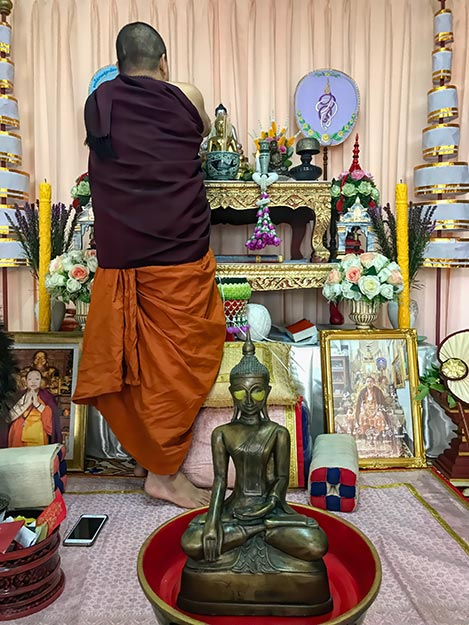
He removed the top tray and dug around in the lower tray until he found a disc of yellow beeswax. Tearing off two small pieces, he molded them into half-moon shapes and pressed them over Buddha’s eyes. The beeswax covering the eyes represents the Buddha prior to his enlightenment and ensures that none of the fiery power being charged into the image will escape. The sealing off also safeguards the sacralization process and protects those in attendance from the intensity of the energy being generated within the image.
Turning again to the rear altar, Phrapalad Thanwa retrieved a large ball of white string known as sai sin in Thai. He tied one end of the string to a previously consecrated Buddha image on the rear altar and unwound the string until it reached my Buddha. He paused momentarily to pick up his mobile, typed something into it, and turned it for me to see. On the screen, big yellow letters on a blue background directed, “You Pray.” I brought my palms together in front of my chest (known as making a wai) and bowed my head as he wrapped the string around the base of my Buddha three times. This sacred string plays an important part in the Buddha statue consecration ceremony, as it is said to transfer the power from the main Buddha image to animate or inanimate images.
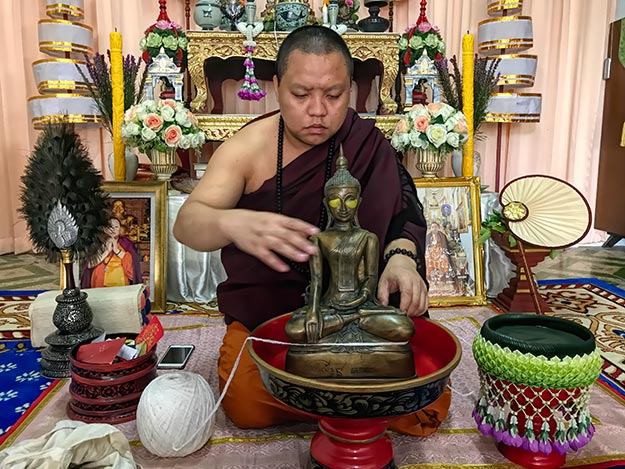
The sacred string is also crucial in sanctifying the holy water used in the ceremony, and it was this that the monk addressed next. He placed a ceramic bowl of holy water (Náam mohn) front and center and removed the lid to reveal several large brown seeds soaking in the water. I assumed these to be Betel nuts. To this he added seven tamarind seeds from a dried tamarind pod. He stirred the concoction with a bamboo whisk, then used the brush to mix a few drops of the holy water with the white clay in one of the brass trinket boxes. When satisfied with the consistency of the clay mixture he replaced the lid and set the holy water aside to soak.
Finally, he placed a single skinny yellow candle and five incense sticks in front of me. I understood from his hand signals that I was to light them all and hand them back to him. I was confused by this. The Theravadan Buddhist tradition prohibits a woman from touching a monk. The rule is so strict that a woman is not even supposed to hand anything directly to a monk. Both the woman and the monk holding the same item simultaneously is considered to be touching.
Instead, women are taught to place items intended for a monk on the floor or on a table. But how could I do this with a lit candle and five burning incense sticks without breaking protocol? I managed the candle by placing it in the pedestal table with the flame hanging over the edge. But the incense sticks were to long. Sending my confusion, Phrapalad Thanwa covered the palm of his hand with a woven silk tapestry and motioned for me to place them onto the material. Whew! An almost-disaster averted. He then placed both the candle and the incense on the rear altar.
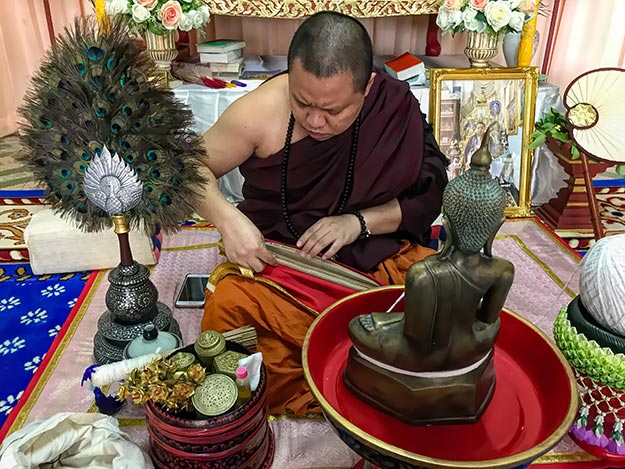
Preparations were now complete. All four elements were present. The white clay represented earth, air peacock feathers represented air, holy water stood for water, and the candle and incense sticks represented fire. It was time to begin the actual ceremony. The monk opened two different prayer books, flipped to the appropriate pages, and indicated I should pray again. I waied and closed my eyes as he began to chant. For more than an hour he recited prayers in tones that ranged from gutteral grunts to impossibly high soprano notes.
I tried to be entirely present but my mind kept wandering. Whenever he uttered a Thai word I recognized, my brain tried to figure out what he was saying. I thought I heard an incantation asking if the Buddha would agree to go back to my home. It is said that a Buddha will not go where it does not want to be. At one point the monk stopped abruptly and asked my name. Seconds later I heard “Barbara” uttered in the midst of the incantations. I heard numbers and place names, such as Chiang Saen.
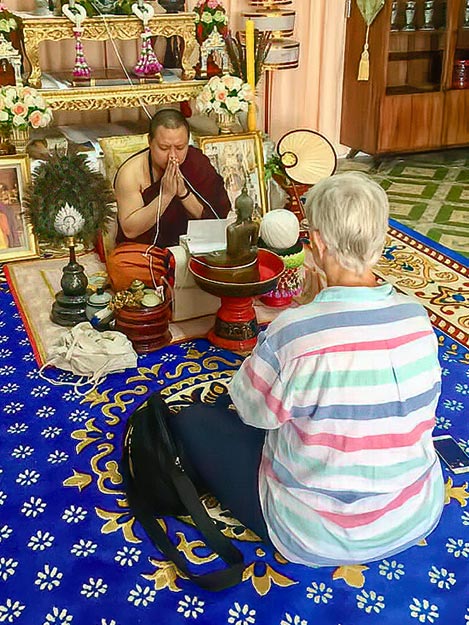
Each time my mind wandered I attempted to refocus. For a while, I was successful. Then my left leg fell asleep. I didn’t know if I was allowed to move so I stayed still. The discomfort increased. I started to sweat. Rivulets streamed down my neck and back. Thank god I wore something loose, I thought. I eventually stopped sweating but then I began to itch. Finally, I couldn’t stand it any more. I shifted from half lotus, splaying my legs to the right and behind me. Unfortunately, that was even more painful. Not only was my left leg in pins and needles as the blood rushed back in, my right hip could not reach the floor in that position. My back started to ache. I wanted to scream. When will this be over? How long is this ceremony?
Recalling that some house blessings I’d attended in the past went on for hours, I started to panic. I changed back to a cross-legged position but struggled to keep my feet from pointing at the Buddha. Again and again I shifted, trying to find a more comfortable position. I focused on my breathing and tried to calm my mind. Little by little, my muscles let go and my hips relaxed but I was extremely relieved when he finally stopped chanting and said, “Open eyes now.”
Phrapalad Thanwa removed the beeswax from Buddha’s eyes and washed the face of the image with a cotton swab soaked in holy oil. This symbolizes Buddha’s attainment of enlightenment. He then dipped the bamboo whisk in the holy water and, flicking his wrist, sprinkled droplets of water on both me and the Buddha. This he repeated three times. Next, he dipped his fingers in the moist clay and daubed spots of it down the Buddha’s torso, more or less where the chakras would be located. Finally, he fanned the Buddha with the peacock feather fan, which is said to cool the heat generated by the transformation of a material object into a living reality. Turning the Buddha to face me he declared, “Very powerful. Buddha’s eyes now open to the world.”
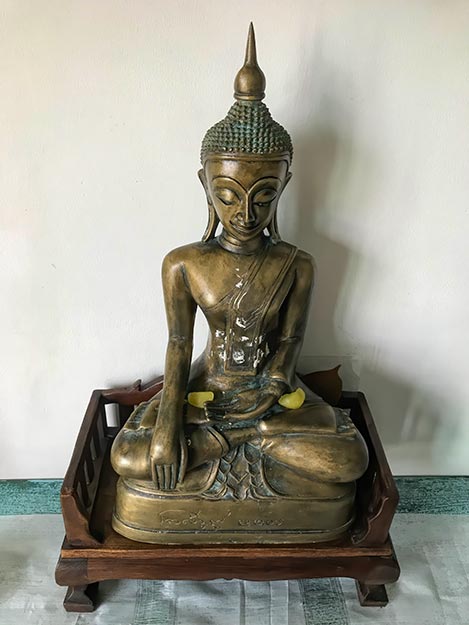
I thanked him profusely and placed 1,000 baht on the lacquer tray, explaining that I intended the donation to be used to repair the leaky roof in his residence. We spent a few moments chatting. I tried, perhaps not too successfully, to interpret his broken English as he showed me photos of his recent trip to a Wat in Minnesota, where he performed the initiation ceremony for an 11-year old American boy as a novice monk. When I thought I could finally stand without falling down, I picked up the Buddha and put it in my carry bag. He stopped me as I was positioning it securely, explaining that I must wai to the image every time I touch it.
I hopped into a Songtheow and made it home just as the afternoon rains started. With great respect I placed Buddha back on my altar, waiing as I had been directed. Over the next few days I began to feel a shift in the energy in my apartment. A sense of peace and calm now pervades my space. It will be interesting to see if the energy of my blessed Buddha will shift anything in my life. At the very least, I hope it will provide me with renewed impetus to meditate more often and longer.
If you enjoyed this story about the Buddha Statue Consecration Ceremony and are interested to know more about Buddhist traditions in Thailand, you may enjoy my stories about locals making merit at the Golden Mount in Bangkok and the New Year’s celebration at Wat Suthat Thepwararam in Bangkok. You may also be interested to check out the Facebook profile for monk Phrapalad Thanwa Khayantam.

Your precise details conveys the intricacies of the ceremony so well. Then your photos add immeasurably to my understanding. Thank you.
And, thank you for your sense of appreciative wonder.
Hi, I came across your story here after Google search about the Buddha statue consecration ceremony. I’m just curious if it’s possible to wrap the consecrated statue in bubble wrap and box to courier it from Thailand to my home country. Is it possible or is it rude? Also, when you have a consecrated statue at home, is it necessary to be a vegetarian? Hope you can answer my questions. Thank you.
Hi Lily: No need to be a vegetarian. Many monks eat meat. As for shipping, it’s not rude to ship it at all. However the issue you may encounter is the antiquities laws. If it is a relatively new piece there would be no issue. But anything that is considered an antiquity needs an export certificate. The shop where you buy it should be able to provide this for you, though it takes a little time to get it.
It’s a very nice story !
I love the Buddha!
Thanks for sharing
Adrian
Thanks for your comment Adrian. Glad you enjoyed it.
Barbara, Words like WOW and AWSOME don’t quite say how happy I am for you to have an “awakened” Buddha to share in your life. Thank you for sharing the ceremony with us.
Hi Tom: Sorry for my slow reply. I’ve been on Easter Island in the South Pacific, with no wifi. Just returned to the mainland of Chile and am catching up. Thanks so much for your comment. I knew you would appreciate the ceremony more than most people in the world. Much love to you.
Thank you Barbara, for sharing the story of your Buddha’s blessings and the ritual. And for being so honest about your discomfort before the ritual is finished. I can almost correlate when I attend mass after my knee replacement, I cannot knell so, I either sit or stand with my head down. Now, I can’t even stand for long because of my lower back pain, so I just sit instead of knelling.
I knew you’d relate Fe. But it doesn’t matter how we sit or kneel, only that we are present.
HI Barbara, are you back in Chiang Mai? I arrive on the 1st. We should have coffee and talk about our friend Larry, aka Lorenzo, and his amazing success at becoming an Italian.
Hi Mindy: Sorry for my slow reply. I’ve been on Easter Island in the South Pacific with no wifi. I will be back to Chiang Mai sometime on the 12th or 13th. Will you still be there? If so, I’d love to get together.
Very intriguing read, Barbara! And I love your Buddha…he’s very unique!
I’ll be home soon and you can see it in person! xo